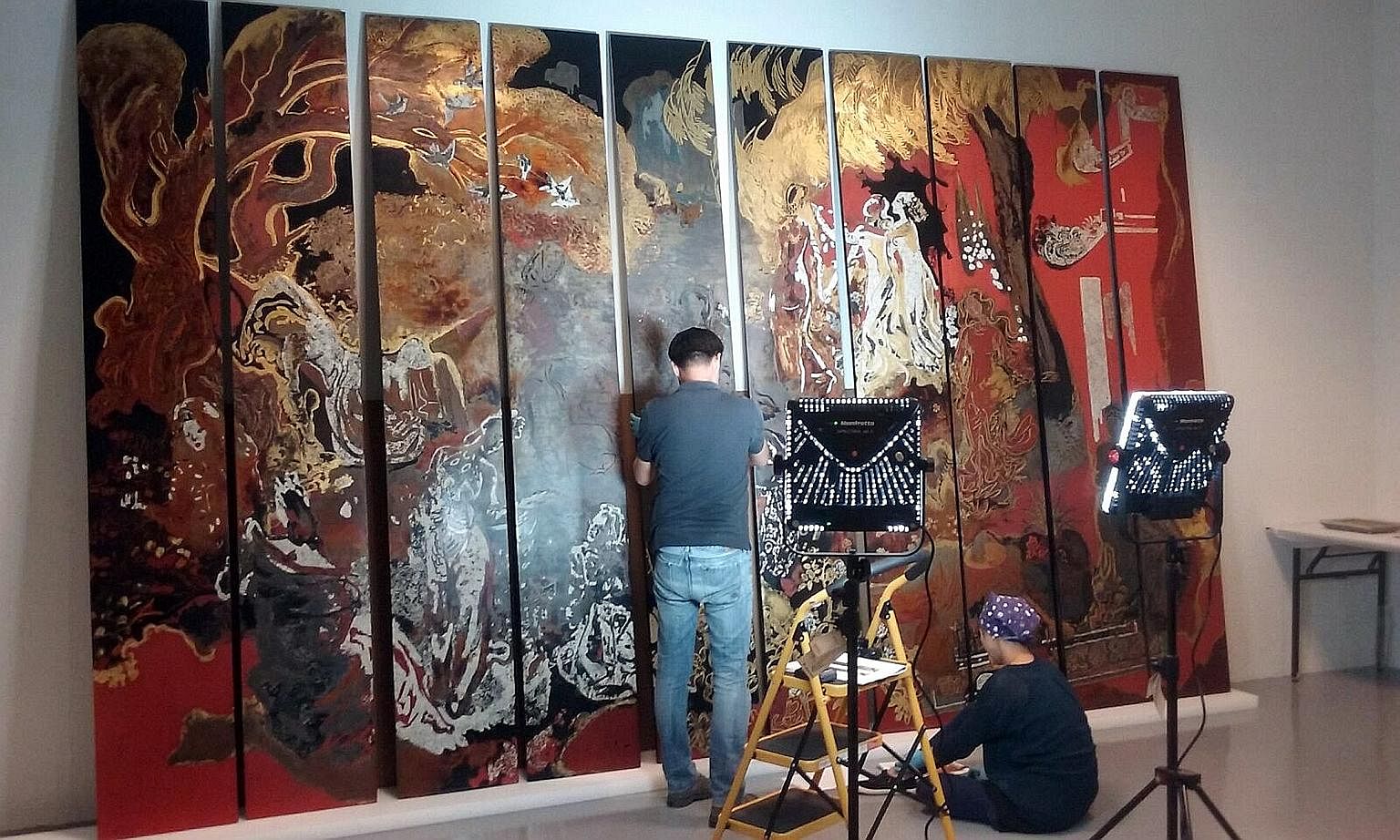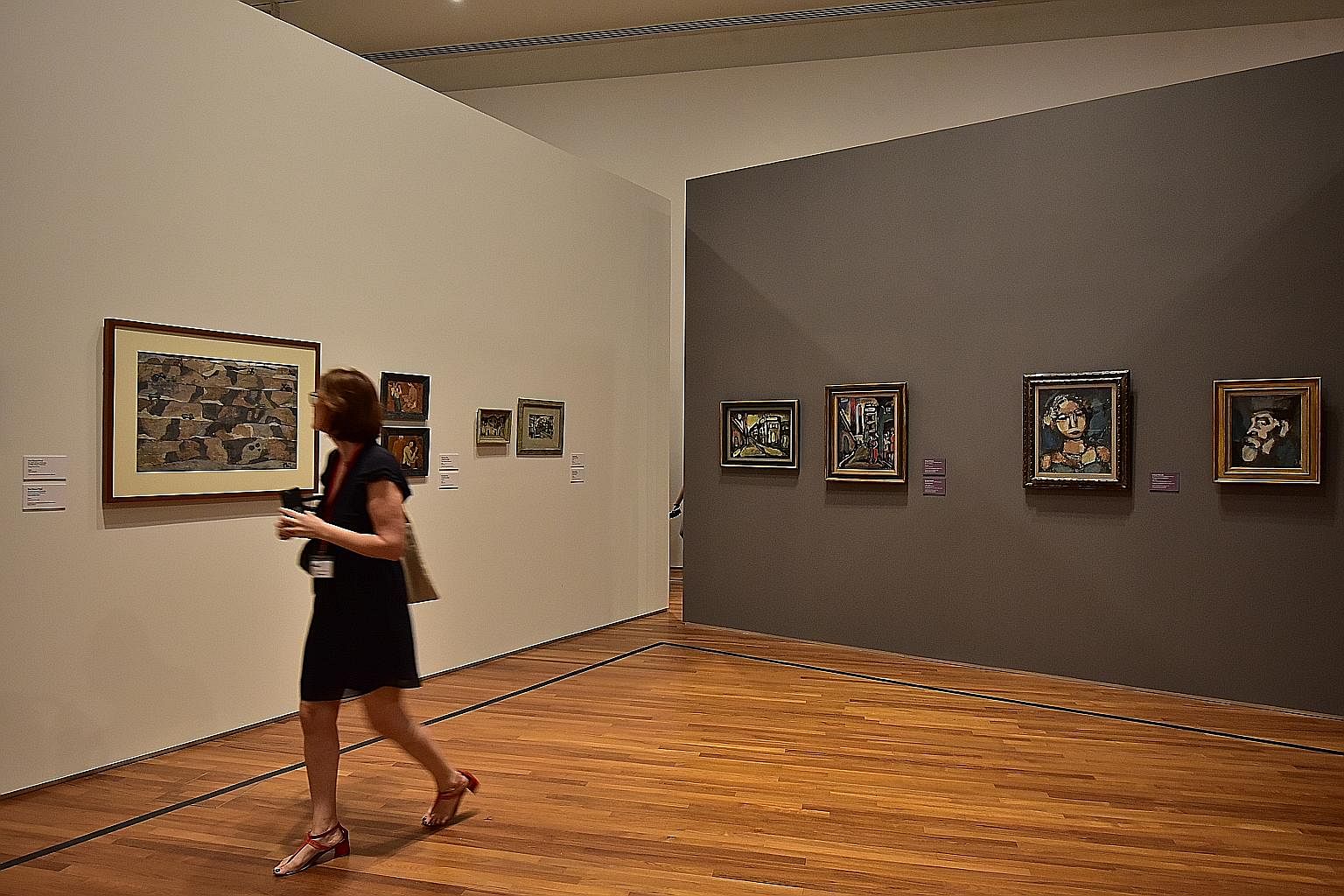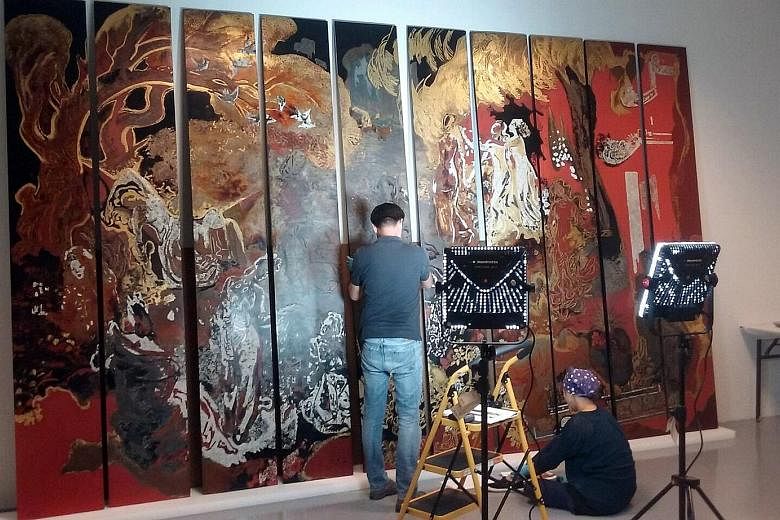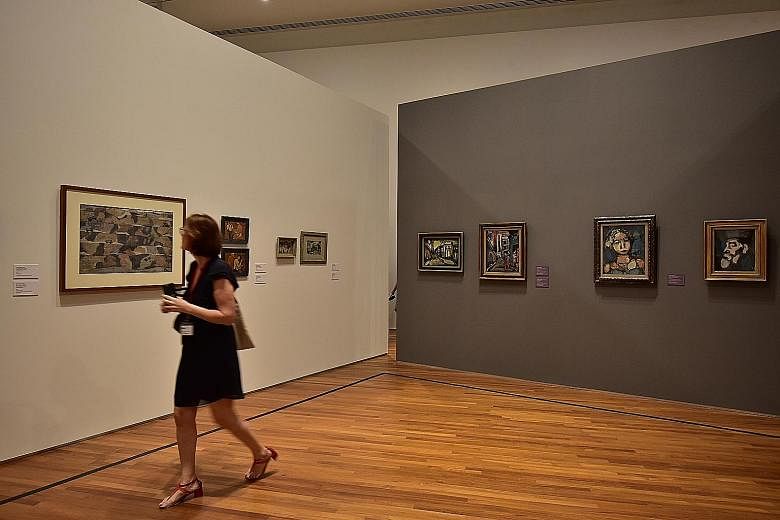In the work titled Interior In Yellow And Blue painted in 1946, French master Henri Matisse uses vibrant, pure colours, strong lines and flat planes to depict an interior landscape that highlights the two-dimensional quality of the image.
This flattening of the image and move away from pictorial illusion was one of the defining features of modernist painting in Europe during that time.
Opposite this painting by Matisse, now hung at the National Gallery Singapore, we can see The Fairies by Vietnamese artist Nguyen Gia Tri from 1939.
Here we can similarly see an image in which the flatness of the picture plane becomes evident, where the female figures meld into the expanse of rich red and brown hues in the large 4m-wide painting, Tri's largest known work.
However, unlike the oil and canvas which Matisse used for his painting, Tri made this painting using lacquer, a medium used in Vietnamese traditional art.
More importantly, the visual qualities that were achieved by Tri resulted from the material characteristics specific to lacquer painting and new techniques employed by him.

How can we make sense of the innovations in visual form and expression in these two works produced in very different contexts, one in Europe and the other in South-east Asia?
The National Gallery Singapore just opened its first major special exhibition, Reframing Modernism: Painting From South-east Asia, Europe And Beyond.
Jointly curated and developed with France's Centre Pompidou, it is the first time that an exhibition like this is happening, where modernism is being examined from the perspective of South-east Asia, with the region as a point of departure.
I co-curated the exhibition with team members Lisa Horikawa and Phoebe Scott, and we worked with the deputy director of Centre Pompidou's National Museum of Modern Art, Ms Catherine David, and curator Nicolas Liucci-Goutnikov.
Centre Pompidou, in Paris, houses one of the most important modern and contemporary art collections in the world, and here, the recently opened National Gallery is home to the world's biggest public collection of modern South-east Asian art.
This inaugural special exhibition, which opens tomorrow and runs until July 17, features more than 200 works from 48 artists. The works of South-east Asian artists such as Le Pho, Cheong Soo Pieng and H.R. Ocampo will be hung alongside Centre Pompidou treasures by masters such as Pablo Picasso, Marc Chagall, Matisse and Wassily Kandinsky.

Why is this significant?
To answer that question, there is first a need to look closer at modernism and understand its relationship to modernity.
Modernity refers to a particular social and cultural context and a set of conditions that emerged due to changes in technology and the theory of knowledge, resulting in what we have come to know as modern societies.
Modernism, on the other hand, can be understood as a reaction to modernity and modern society. It is linked to the intellectual movement of the late 19th to 20th century originating in Europe and to the new ways of thinking about the world resulting from industrialisation, science and philosophy. It has also been interpreted as the rejection of tradition and a celebration of the new and original as having inherent value.
In the visual arts, painting specifically, this meant the rejection of the conservative academic conventions of painting. In their place, artists used new forms and languages of expression which they felt were necessary to represent the new conditions of their fast-changing and modernising societies.
Artists focused instead on the "pure" qualities of painting, such as flatness and two-dimensionality. This shift has been seen as the beginning of abstract painting, which came to exemplify the new modernist art.
The relationship between abstract painting and modernist art was espoused most famously by US art critic Clement Greenberg.
For Greenberg, abstract art was an inevitable symptom of modernism and grew out of modernism's essential drive to assert its own autonomy. It achieved this by being self-reflexive, referring to nothing outside itself and, in the process, negating anything which did not emphasise this autonomy, including representation.
In the visual arts, the dominant perspective of modernism as advocated by Greenberg was as a series of formal developments in abstraction that began with the Cubist artists and early abstract artists such as Picasso, Georges Braque, Matisse and Kandinsky, and continued by the American abstract expressionist artists such as Jackson Pollock after World War II.
While this paradigm of modernism has since been challenged, it has come to dominate understanding of modernism in Europe and the United States, as well as the development of contemporary art.
A LOCAL TAKE ON MODERNISM
How, then, is this relevant for art in South-east Asia?
The story of modernism around the world is often told as one of influence: How styles from the West influenced art elsewhere, which creates an implied hierarchy. But while these influences are important, they are not the whole story. Artists in South-east Asia developed and adapted their own kinds of modernist painting, based on local concerns and aesthetics.
Take the development of modernism in Indonesia. Indonesian artist, curator and theorist Jim Supangkat's articulation of this provides an example of how the development of modernism in South-east Asia can be perceived differently to Euro-American modernism.
Supangkat argued that modernism in Indonesia emerged during the 1930s, during the transition from landscape painting to the social realist painting exemplified by artists such as S. Soedjojono.
Soedjojono was critical of the prevalent art of the time, landscape or Mooi Indies (Dutch for "Beautiful Indies") painting by artists such as Basoeki Abdullah and Wakidi. He considered them conservative and feudalistic as they seemed to cater to the tastes of the Dutch colonialists and were, furthermore, removed from the social realities of Indonesia.
Whereas the Mooi Indies painters depicted idealised scenes of natural beauty, Soedjojono argued that art should reflect the social realities of the time instead of conforming to notions of beauty created by feudalism and Dutch colonisation.
In addition to this "honest" and more significant role that Soedjojono saw for art in modern Indonesian society in its reflection of social realities, he also extended this "honesty" to the formal qualities of the paintings themselves. He argued that a work of art must manifest the "inner soul" of the painter, as this was ultimately what gave value to the work of art.
As Supangkat put it: "This discourse of modernism was different than that of the modernism of Europe. This modernism, as well as the conservative values which it rejected, were local products rooted in local realities."
He asserts instead that the framework of "kagunan" is a more useful one to understand the development of modernism in Indonesia. The term "kagunan" is derived from Javanese culture and can most closely be translated as "fine arts".
Soedjojono's modernism can be seen on one hand, to reflect the "honesty" of Indonesian society in its adoption of realist styles and, on the other hand, to reflect Indonesian-ness through the souls of the artists.
Therefore, the development of modernism in Indonesia can be seen, not as a formalist reduction and negation of representation and subject matter, but as a rejection of feudal and colonial notions of art and aesthetics. It was also about reasserting a vernacular and local, Indonesian notion of aesthetics, rooted in Javanese culture, as well as highlighting the important role of art in modern society.
The exhibition, Reframing Modernism, therefore takes the practice of an artist such as Soedjojono and presents it together with artists working in Europe who shared similar strategies in their work, such as Edouard Pignon who, while adopting an abstracted language, similarly did not reject representation, but saw their modernist development as reflecting social reality.
The exhibition makes connections between artists based on the particular visual, conceptual or social problem that each artist was considering in their work, rather than relying on ideas of influence, or stylistic terms derived from a European, Western context.
In the case of Indonesia, as with the development of modernism in other countries in South-east Asia, it was not merely a case of influence from European modernism, but rather how artists responded to the local conditions and concerns as well as acknowledging the role of art in modern societies.
In the same way that modernism in South-east Asia should not be seen as simply mirroring developments in Europe and the United States, this also provides a basis for us to re-evaluate our understanding of the development of modern and contemporary art in the region, which is one of the key missions of the National Gallery Singapore.
• The writer is director of the National Gallery Singapore. The Reframing Modernism exhibition opens tomorrow and ends on July 17. Tickets at $15 for Singaporeans and permanent residents are available at the gallery or online.


